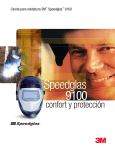Download Triumph TR7 TR8 Clock Repair
Transcript
Triumph TR7 TR8 Clock Repair Greg Bober, Copyright 17 March 2012, Rev 2.7 (originally written 4 July 2005) The following information is presented as "public knowledge" and is only for the personal use of individuals who are either restoring or repairing their own Triumph TR7 or TR8 vehicle's clock. The information may not be used commercially without the consent of Greg Bober (the author), who can be contacted via [email protected]. Triumph car clubs can reprint this as a monthly newsletter article, but please Email [email protected] so I know where in the world this has been reprinted. Thanks. Abstract The 1975-1982 Triumph TR7 and TR8 car clocks contain 2 defects that can effect its successful operation in the vehicle's local environment. This document describes how a person with a limited skill level in electronic component soldering and automotive vehicle repair can correct these 2 particular defects to obtain a more reliable Triumph TR7 TR8 vehicle clock. The first defect, or shortcoming, is that the clock was designed for approximately a +25 oC +/–10 oC temperature operation environment. This was a common automotive design standard used into the Picture 1: The TR7/TR8 clock in instrument cluster mid 1990's by a few major auto companies. Thus in colder climates, such as 0oC, the clock will just stop. The second defect, is that the clock's timing mechanism is critically balanced between the force of a timing spring, the electro-mechanical force applied via an electric coil, the distance a feedback magnet is from a feedback coil, the vehicle's voltage, the amplification provided by a transistor, the friction of the clock's escapement gears and many other tolerance items. There is a spot where everything balances, the clock "stalls" and stops operating. The clock will only start operating again, if the "right" kind of bump in the road (vibration) or electrical transient (like starting the car) is encountered to jiggle the clock's pendulum back into motion. Although I’ve designed analog clocks for the Ford Expedition, Navigator, Jaguar XJC, the modern retro Mangusta, Lincoln Town Car and a few others using custom parts from Swatch, I choose not to use those particular Swatch parts. The Swatch parts are still used by many automotive suppliers around the world for many mass production vehicles, but the parts are not publicly available for sale unless you rummage through the scrap yards for the dash panel board clocks of the appropriate vehicles. Plus the Swatch clock motor mechanism only has an hour and a minute hand. I’ve seen others replace their TR7 TR8 clock for little round digital clocks. I wanted to keep the original TR7 TR8 dash appearance and functionality (hour, minute and second pointers). The provided instructions present how I electrically modified an original TR7 TR8 to improve the original clock’s reliability while maintaining the original dash panel appearance. Page 1 of 9 Saturday, March 17, 2012 Read this First Read all instructions before starting the repair procedure. Tools Required: • screwdrivers • small nose pliers • small wire cutters • 25W to 50W soldering iron • acid free solder • wood or plastic tooth pick • Dremel Hobby Drill or Exacto Knife or equivalent Electronic Components Required • Qty = 1, 100 or 110 Ohms 0.25W 5% Carbon film resistor (brown/black or brown/brown/gold stripe on component). Note: the 100 or 110 ohms resistor is not needed if CD33321 is used. • Qty = 1, 3.0K Ohms 0.25W 5% Carbon film resistor (orange/black/red/gold stripe on component) • Qty = 1, 1N4001, or 1N4002, or 1N4003 or .... 1N4008 rectifier diode (referenced as 1N400x) • Qty = 1, Holtek 14L, or 14LTO-92, or HT-2014L, HT-2014LTO-92 or CD33321 transistor IC (This part is hard to find, but easy to install, and works better than alternative parts I've tried. The “TO-92” describes this component's plastic encasement.) These parts are available from some electronic stores. Or contact me at [email protected] for a kit: • Qty = 1 set of electronic parts $6.00 USD with additional sets of parts $4.00 USD each. The price includes worldwide shipping (Canada, California, UK, New Zealand is all about the same, the envelope weighs the most). This can be paid via PayPal to my email address or send a check to: Greg Bober 22421 Edmunton Saint Clair Shores, MI 48080 USA (US personal check OK, or international bank, Postal, VISA, American Express, Barclay's checks) • I can install these parts if the entire clock unit is sent. Shipping costs back to the owner is still at the owners expense (PayPal payment is acceptable). Email before shipping. Additional Items Required (used to test and power the clock when away from the car) • 9V battery • 9V battery clips with a short distance of wire • paint pen or colored finger nail polish • and about 1 hour of time Page 2 of 9 Saturday, March 17, 2012 Other Reference Documentation • TR7 Service Manual, AKM3079B Published by BL Car Limited, 1981 or • TR8 Repair Operations Manual (ROM), AKM3971, BL Cars Limited, 1980 Clock Removal From Vehicle Reference: TR7 Service Manual page 454 or TR8 ROM page 351, Procedure 88.15.07 1. Disconnect + positive cable from vehicle's battery. 2. Unbolt clock setting cable at cross beam eye-let along lower edge of dash cross beam (on some cars it just dangles down into the foot well). 3. Remove center speaker grill on top of instrument panel. 4. Remove top of instrument panel fascia above Instrument Gauge Cluster (4 screws along top of fascia, 3 along bottom edge, 7 screws total). 5. Remove 2 screws attaching top rear of Instrument Gauge Cluster to top fascia panel. 6. Remove 3 screws from top edge of Instrument Gauge Cluster lens. 7. Remove 2 screws attaching bottom of Instrument Gauge Cluster to knee level fascia panel. 8. Slide Instrument Gauge Cluster lens upward along curved contour of dash fascia. 9. Pull black plastic mask toward steering wheel. 10. Remove the two screws attaching the clock to the Instrument Gauge Cluster housing. 11. Remove clock by pulling clock forward toward steering wheel 5cm or few inches. 12. Disconnect clock time setting cable (knurled nut) from behind the clock unit. 13. Note: it is not necessary to remove the Instrument Gauge Cluster from the vehicle nor it is necessary to pull out or remove clock setting cable completely. Pre-Testing the Clock • With a battery clip, connect the 9V battery's + terminal to the clock's rear flat terminal and the 9V battery's – terminal to clock's metal housing or threaded bolt above the clock setting cable connection shown in Picture 2 (the clock’s metal housing isn’t always electrically connected). • Note: one end of the clock's pendulum can be seen by looking under the metal cover shown in Picture 2 (look through the gap between the metal housing and the brass support post). • Orient the clock as if installed in the vehicle to allow the escapement gear to work with gravity. • The clock might start on its own; if already started, gently and deliberately stop the clock's pendulum with a tooth pick near the center of its swing. • The clock is “stalled” if one pulls the toothpick away without the pendulum moving. At this point if the clock was moving, and now it’s not, it can’t start on its own. • With the toothpick, move the pendulum 3mm right or left, and pull the toothpick away. The pendulum should start swinging with increasingly larger swings until operation resumes. Page 3 of 9 Picture 2: 9V battery test set up Saturday, March 17, 2012 • • • If the clock restarts after you've induced movement into the pendulum, then this procedure and corrective action will help your clock. If the clock stops again after you've induced movement into the pendulum, then your clock has other troubles (check the battery connections, broken clock spring, broken coil(s), etc.) I noticed that if the clock makes a small clanking and clunking sound, it’s the escapement gears binding (often loosens up after 30 seconds, 1 or 2 clock ticks). Clock modification 1. Using a paint pen, or colored finger nail polish, identify and mark the following circuit locations (or at least be familiar with these locations) as shown in Pictures 3 and 4. 2. The Green dot represents the clock's Ground (lower right most electrical connection on the clock's circuit board). 3. The Purple dot represents the clock's feedback bias (this appears as a diagonal circuit trace from the lower corner of the circuit board). 4. The Light Blue dot represents the clock's existing transistor's "emitter" (2nd electrical connection from the lower left corner of the clock's circuit board)—don't count the little hole in the circuit board trace. 5. Skip over the 3rd electrical connection from the lower left of the clock's circuit board (do not connect anything to this electrical location, its the Battery+ terminal). 6. The Red dot represents the clock's existing transistor's "collector" (4th electrical connection from the lower left corner of the clock's circuit board). 7. Cut the leads from the 1N400x diode and 3.0K resistor so each lead length is 3mm. 8. Using a Dremel Hobby Drill or Exacto Knife, cut the circuit board trace at the Purple dot’s location. 9. Across this newly cut circuit trace, solder the 1N400x diode with the diode's anode band to the lower left corner as shown in Picture 4. 10. The diode's anode (white or gray banding end of the diode’s body) should be soldered to the existing solder pad in the circuit board's lower left corner and share one end of the 3.0K resistor. The other end of the 3.0K resistor should be soldered to the Green dot’s circuit location. Picture 3: Location and marking the locations noted IF "14L" transistor IC is being used: • Cut the leads from the 110 Ohm resistor so each lead's length is 2mm. Page 4 of 9 Saturday, March 17, 2012 Picture 4: Temperature Compensation Diode and Resistor • • • • • • • If 14L IC is being used, cut the center lead of the new 3 leaded transistor IC to half the length of the outer leads. Solder one end of the 110 Ohm resistor vertically to the Light Blue dot’s circuit location. See Photo 5. Solder the "G" labeled lead from the new transistor IC to the Green dot’s circuit location. See Photo 5. Solder the "V" labeled lead from the new transistor IC to the Red dot’s circuit location. This is hidden by the 110 Ohm resistor in Photo 5. Solder the center lead of the new transistor IC to the unused end of the 110 Ohms resistor (the center lead is sometimes marked as “L”, and sometimes mark “O” see Picture 5). Note: the new transistor IC will operate as the clock's “pace maker” or “watchdog timer”. Verify the 3rd electrical connection from the lower left corner has nothing connected to it or touching it. If an accidental connection is made to this location, the components will “smoke” when powered and the clock’s coil will become un-repairable (I learned from making this Picture 5: 14L transistor IC added mistake). IF "CD33321" transistor IC is being used: • The 110 Ohm resistor is not needed, a resistor is built into the CD33321. • Solder the "right" lead from the new transistor IC to the Green dot’s circuit location. • Solder the "left" labeled lead from the new transistor IC to the Red dot’s circuit location. • Solder the "center" lead of the new transistor IC to the Light Blue dot. • See Picture #5, orient the 33321 the same as the 14L as shown in Picture 6: 33321 added the Picture 5. • Note: the new transistor IC will operate as the clock's “pace maker” or “watchdog timer”. Page 5 of 9 Saturday, March 17, 2012 • Verify the 3rd electrical connection from the lower left corner has nothing connected to it or touching it. If an accidental connection is made to this location, the components will “smoke” when powered and the clock’s coil will become un-repairable. Testing the Modified Clock • Refer back to Picture 2. • Through a battery clip, connect the 9V battery's + terminal to the clock's rear flat terminal and the 9V battery's – terminal to clock's metal housing or threaded bolt above the clock setting cable connection shown in Picture 2 (the clock’s metal housing isn’t always electrically connected). • Orient the clock as if the clock were installed in the vehicle to allow the escapement gear to work with gravity. • The clock will be able to start on its own; if already started, deliberately stop the clock's pendulum with a toothpick near the center of its swing. • The clock is "stalled" if one pulls the toothpick away without the pendulum moving. • The newly installed transistor IC will make the pendulum wiggle 1 time per second. • The new transistor IC will induce increasingly larger pendulum swings until operation resumes. • It can take a few seconds to 1 minute to build up the energy needed to overcome any friction in the pendulum. Debug, Possible Mistakes • If operation doesn't begin, or no movement is detected, check component orientations. • Make sure the battery isn't dead or voltage under 8V (my clock worked OK with 8.7V). • Check the polarity of the newly added diode. • Check all newly added solder joints. • With an ohm meter, the added 3.0K Ohms resistor should read as 1800 Ohms (the 3.0K is in combination with another clock resistor yielding the 1800 Ohms measurement). • The voltage across the added 3.0K Ohms resistor should be near 1.1V +/- 0.1V. • The voltage across the added diode should be near 0.6V. • The voltage at the new transistor IC's "left" or "V" leg should be the same. Re-Installation of Clock Into Vehicle Reference: TR7 Service Manual page 454 or TR8 ROM page 351, Procedure 88.15.07 1. If necessary, Clean the inside of the Instrument Gauge Cluster. 2. If necessary, clean and polish Instrument Gauge Cluster lens (I used Mother's California Gold Scratch Remover, most automotive supply stores "will" have this or something similar). 3. If necessary, renew the foam rubber strips along top and bottom edges of the lens (I used "Soft Touch" Ultra Heavy Duty Felt with Adhesive 1/2" Wide Strip by Waxman #2200 obtained from a home hardware store). 4. Inspect the second, minute and hour pointers to insure no accidental bending occurred, re-flatten if necessary. 5. Follow the Clock Removal From Vehicle procedure in reverse order. Page 6 of 9 Saturday, March 17, 2012 Done! Pat yourself on the back and go for a road trip. Clock Test Data (sample size = 1, my own TR7 clock testing both CD33321 and 14L versions) • pendulum cycle rate, 2.5Hz or 400mS • over 18 Hr period the "14L modified" clock showed no loss of time accuracy • the clock self started from "stalled" position and operates at 8.5V @+25 oC or 75 oF • the clock self started from "stalled" position and operates at 11.0V @-12 oC or 10 oF • "original" clock operating current near 4.7mA, "14L modified" clock operating current about 5.7mA average @12V • if 0 Ohms with 14L is used instead of 110 Ohms, operating current > 6.5mA time averaged • if 300 Ohms with 14L is used instead of 110 Ohms, the force from coil can't overcome extra friction from frost • the CD33321's operating current is 1mA less than 14L transistor IC operating current Theory Behind The Operation and Modifications Normal Clock Operation: When the voltage is applied to the clock unit, a bias voltage is applied to one end of a feedback coil under the pendulum. This bias voltage will always be about 13% of the vehicle's voltage. The other end of the feedback coil is connected to an NPN type transistor. The transistor drives another coil under the pendulum to make the pendulum swing against the force from the clock's timing spring. When the pendulum swings in the direction pulled by the clock's timing spring, the magnet on the pendulum induces a >0.1V drop in the feedback coil and thus the bias voltage lowers enough to turn the transistor "off". When the pendulum motion stops the transistor turns back "on" and pulls the pendulum back until the clock's timing spring will not allow additional travel. During this motion, the magnet on the pendulum induces >0.1V additional voltage in the bias to turn the transistor "on" harder to allow the coil to pull the clock's spring out as far as possible. When the spring has traveled as far as possible, the added bias voltage is no longer given, the transistor begins to turn "off", and the pendulum motion reverses direction restarting the swing cycle. Each swing cycle will allow the escapement gear mounted on the pendulum shaft to "tick" or count one 400mS moment of time. Temperature (and Voltage) Compensation The NPN drive transistor has a PN Silicon alloy "junction" (example: one part might be Silicon mixed with a tiny bit of Aluminum and the other being Silicon mixed with a tiny bit of something else). When there is more than 0.6V @ 25 oC across this junction (the transistor's "base" and "emitter" pins) the transistor's "collector" and "emitter" junction will activate to conduct current. Relative to this basic NPN transistor characteristic, the TR7 clock has two problems: 1st, as the vehicle voltage changes over engine RPM, environmental temperature and electrical loading, the 13% bias voltage changes. But the clock spring's tension force capability doesn't change; 2nd, the transistor's PN junction changes about 0.0024V for each degree Celsius of temperature change. At hot and cold temperatures the transistor's "on and off" thresholds change significantly, especially when it’s 0 oC or 40 oC. By installing a diode with a similar junction into the bias voltage circuit, the bias voltage will shift up and down with Page 7 of 9 Saturday, March 17, 2012 ambient temperature almost identically to any temperature shifts experienced by the clock's transistor. Also, since the diode's voltage drop of 0.6V will be almost constant, it will make the feedback bias voltage 50% less dependent or sensitive to the vehicle's system voltage. The added resistor adjusts the bias voltage back to the original clock's bias voltage point. Pace-maker or Getting a Kick Start If there is no motion in the pendulum, then there isn't an adding or subtracting voltage being induced into the feedback coil to turn "on and off" the transistor. This "stalled" location in the pendulum's swing is where the electro-motive force from the transistor-driven coil matches the clock's timing spring's tension force resulting in no motion. The modification is to add a low voltage oscillator to disturb the balancing forces and toggle the transistor "on" and "off" to induce some motion into the pendulum. The normal operating cycle of the clock's pendulum will be restored once there is sufficient motion for the feedback magnet to induce the addition or subtraction of bias voltage to the bias circuit controlling the transistor's "on" and "off" toggling. Acknowledgements Special thanks goes to James TenCate, Odd and Lena Hedberg for proof reading this article, adding TR8 Service Manual Reference information and a new Photo #1, a sharper image of Photo #3 and a new Photo #6 with the CD33321. Biography Sorry can’t find a picture of me, but here’s my TR7. I’ve been a part of designing automotive electronics since 1986. Since 2008 I’ve been working for LG-Chemical on Lithium Ion battery storage systems for commercial truck and passenger vehicle applications. My prior experiences have been with Ford Motor Co. and Visteon Electronics. Page 8 of 9 Saturday, March 17, 2012 To my credit, I’ve designed the control electronics for many different suspension / steering control modules, body illumination modules, dash panel clocks, and multi gauge instrument clusters (examples are Thunderbird Super Coupe Shock/ Steering module, Lincoln Mark 8 Shock Module, Jaguar XJC clock, Jaguar ‘S’ Class cluster, Lincoln LS cluster, Nissan Quest/Mercury Villager cluster, plus more). From 2002 to 2005 I restored the above a California EFI type TR7 Spider using many methods of improvement applied to current production vehicles for electrical power distribution and fusing strategies. The CD player, electric radiator fan, Honda RSX seats and Bosch alternator are the only non- TR parts installed on the car. This TR7 now has reliability similar to that of a new car, I sometimes drive it to work (70 miles round trip). For the curious, the vehicle gets 30MPG on mixed city / hiway driving. Page 9 of 9 Saturday, March 17, 2012





























